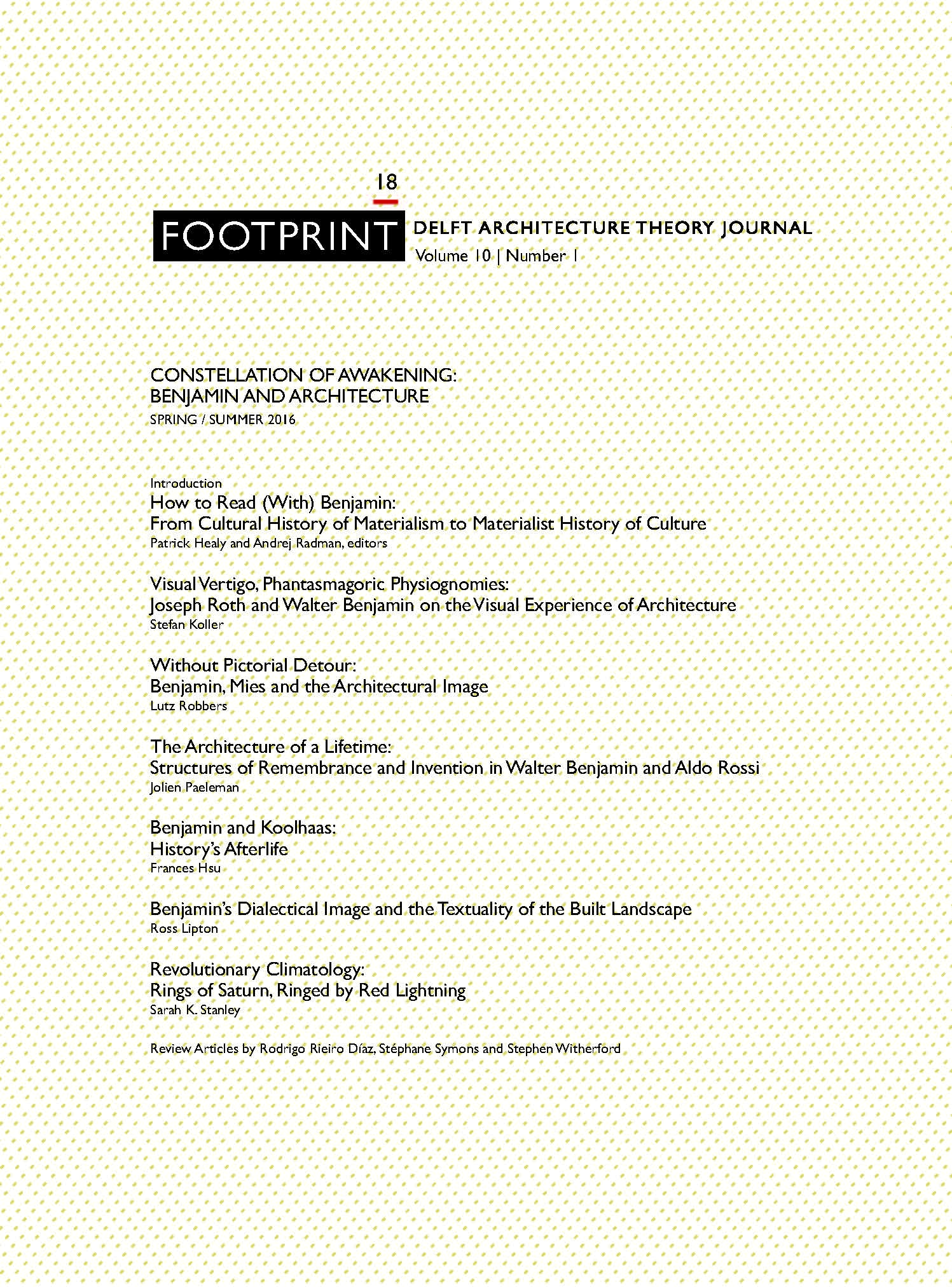The Memory Works: Between Monuments and Ruins, The Case of Contemporary Budapest
DOI:
https://doi.org/10.7480/footprint.10.1.971Abstract
This review article argues that Benjamin’s project to construct a political explanation of the surrounding cultural world in developed capitalist societies, raised to a source of knowledge about the historical truth, finds an unmatched case of study in the contemporary ruinous urban nature of Budapest. Departing from the park of statues Memento Park, some urban features of the city are examined in the light of Benjamin’s semantics of the fragment to try to answer whether these thoughts apply to the discarded material world of our time. Could the already-there in Budapest provide a motivational basis for a reconstruction of the surrounding material world from the fragments of the past? The local phenomenon of romkocsma is addressed to wonder whether re-use of ruins could house this emancipatory potential or serve the interests of the hegemonic groups and the contemporary dominant discourse.
References
Susan Buck -Morss, Dialéctica de la mirada. Walter Benjamin y el proyecto de los Pasajes [The dialectics of seeing. Walter Benjamin and the Arcades project] (Madrid:Visor, 1995(1989))
Otthon Centrum, “Panelpiac – túl a mélyponton?” [Panelház market, beyond the lowest point?], August 2006. Accessed June 29, 2015, http://http://www.oc.hu/ingatlanpiac/269
KSH (Központi Statisztikai Hivatal), “Magyarország Helységnévtára, 2012” [Hungarian Census 2012], 2012. Accessed June 29, 2015, http://http://www.ksh.hu/apps/!cp.hnt2.telep?nn=23649
Pál Germuska, “Between theory and practice: Planning socialist cities in Hungary,” in Tom Misa and Mikael Hård (eds.), Urban machinery: Inside modern European cities, 1850-2000 (Cambridge MA: MIT Press, 2008), 233-255.
KSH (Központi Statisztikai Hivatal), “Helységnévkönyv adattár 2011” [Cadastre 2011], 2011. Accessed June 29, 2015, http://portal.ksh.hu/pls/ksh/docs/hun//hnk/Helysegnevkolyv_adattar_2011.xls
Sándor Hegedűs, “Védnökség a mártírsírok felett: Kalamár József” [Patronage of the tombs of the martirs: József Kalamár], 2008. Accessed June 29, 2015, http://www.aszabadsag.hu/cikkek/2008/19/mozgalom.html
Ivan Tosics, “Housing renewal in Hungary: from socialist non-renovation through individual market actions to area-based public intervention”, in Richard Turkington and
Christopher Watson (eds.), Renewing Europe's Housing (Bristol: Policy Press, 2015), 161-186.
Forgács Peter, “Arqueología del tiempo o memorias alternativas” [Archaeology of time or alternative memories], in Documentamadrid 2011 (Madrid: Documentamadrid, 2011), 320-322 (322).
Walter Benjamin, Libro de los pasajes [The Arcades Project] (Madrid: Akal, 2005(1940)), 309.
Ian Cook, “Are you ready to move?”, 2009. Accessed June 29, 2015, http://www.lefthandrotation.com/museodesplazados/ficha_cook.htm
José Manuel Romero Cuevas, “Sobre la actualidad de Walter Benjamin” [On the present relevance of Walter Benjamin], in Constelaciones 2 (2010): 371.
Saskia Sassen, “The informal economy: Between new developments and old regulations”, The Yale Law Journal, 103 (1984): 2289-304
Margaret Crawford and Tobias Armborst, “Don't obsess about permanence... A conversation between Margaret Crawford and Tobias Armborst”, in Philipp Oswalt, Klaus
Overmeyer, Philipp Misselwotz (eds.), Urban catalyst. The power of temporary use (Berlin: DOM Publishers, 2013), 105-116.
Downloads
Published
Issue
Section
License
- Authors retain copyright and grant the journal right of first publication with the work simultaneously licensed under a Creative Commons Attribution License that allows others to share the work with an acknowledgement of the work's authorship and initial publication in this journal.
- Authors are able to enter into separate, additional contractual arrangements for the non-exclusive distribution of the journal's published version of the work (e.g., post it to an institutional repository or publish it in a book), with an acknowledgement of its initial publication in this journal.





